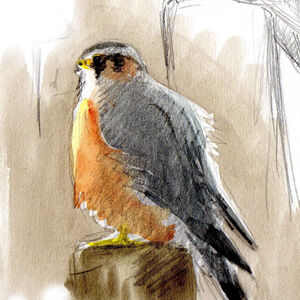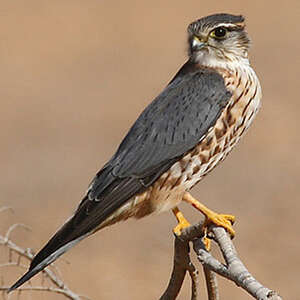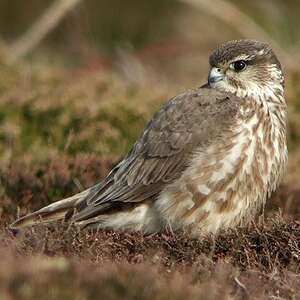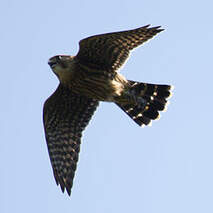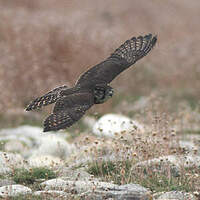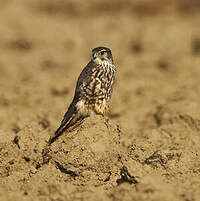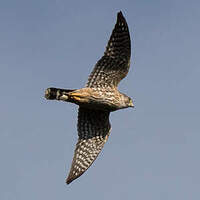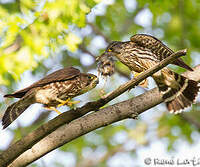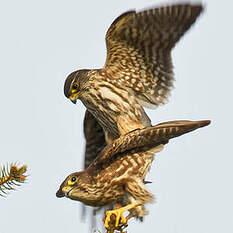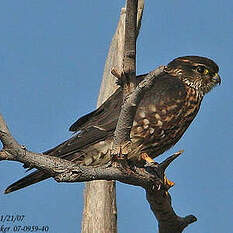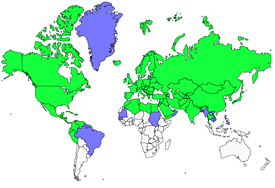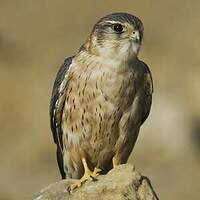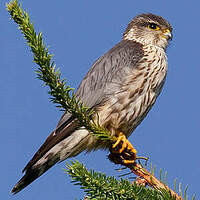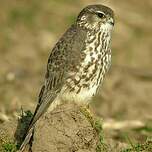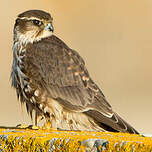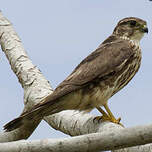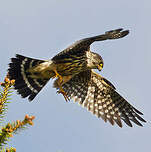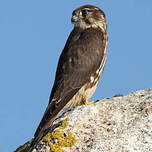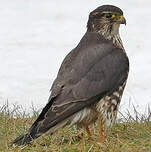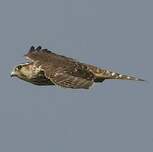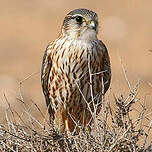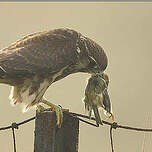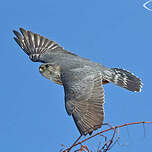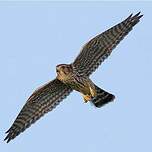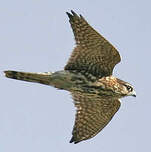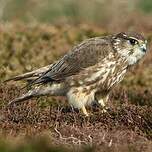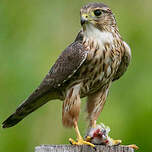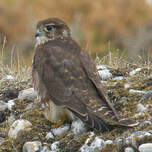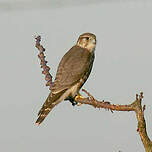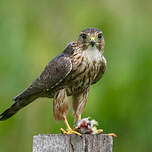Merlin
Falco columbarius - Faucon émerillon
Identification
The Merlin is a small, compact falcon, with a unique silhouette and flight. Its closest resemblance is to the Sparrowhawk as they are roughly the same size, rather than to any other falcon. When perched, its short wings only go up to 2/3 or 3/4 of the tail; also the flight is quick and low, similar to the Sparrowhawk, however the pointed wings and style of wing beats are what set them apart. The trouble is usually one is presented with only a fleeting view of a small bird of prey passing by in a hurry and disappearing out of sight before any details of plumage can be observed. Yet, when the fortune of stumbling across one perched at a low elevation presents itself, it is a different story. Despite this, the long tail and eyebrow are evocative of the Sparrowhawk. There are 9 subspecies throughout the northern hemisphere in which we are particularly interested in Salaon ssp. of northern Europe, the one that can be seen in France from October to March. During this time, the male has migrated to Africa.
The adult male is smaller than the female, by at least 25%. It only weighs 160-170 g with a wingspan of 50-60 cm. Its greyish blue upperside, finely streaked with black is typical, as well as its black primaries edged with grey, grey rectrices with a black terminal bar. The underside is coloured rufous with fine brown streaks, especially around the thighs. The head is smooth with no crest. The crown and hind cheeks are streaked grey. A pale eyebrow is wedged between the two and a dark tear is visible under the eye on the rufous background, recalling the moustache of other falcons. The throat is pale, the iris is dark, the beak is greyish blue with a black tip, the cere and legs are yellow.
The female is visibly larger and the plumage is similar to that of the male, except the grey is replaced by brown.The upper parts are brown. The underside doesn't have any russet and is more clearly striped with brown. The flanks appear roughly barred with brown. The wings and tail are dark brown and barred with whitish.
Most of the sightings in France are of female type birds, probably juvenile or immature, very brown birds on top, with fringed tectrix chamois and marked with a black rachial line, and very marked below with large spots on the sides. The wax is not bright yellow.
Subspecific information 9 subspecies
- Falco columbarius columbarius (Alaska to Newfoundland to n USA)
- Falco columbarius subaesalon (Iceland)
- Falco columbarius aesalon (Europe to nw Siberia)
- Falco columbarius insignis (nc Siberia)
- Falco columbarius pacificus (ne Asia)
- Falco columbarius pallidus (steppes of wc Asia)
- Falco columbarius lymani (mountains of ec Asia)
- Falco columbarius suckleyi (se Alaska to n Washington. USA.)
- Falco columbarius richardsonii (c and sc Canada to nc USA)
Foreign names
- Faucon émerillon,
- Esmerejón,
- esmerilhão,
- Merlin,
- kis sólyom,
- Smelleken,
- Smeriglio,
- stenfalk,
- Dvergfalk,
- sokol kobec,
- dřemlík tundrový,
- Dværgfalk,
- ampuhaukka,
- esmerla,
- Smyrill,
- drzemlik,
- purva piekūns,
- mali sokol,
- Дербник,
- コチョウゲンボウ,
- 灰背隼,
- เหยี่ยวเมอร์ลิน,
- 灰背隼,
Voice song and cries
Take note of the alarm calls emitted by adults on their territory. The male Merlins make a rapid and shrill ki ki ki ki ki ki... sound, as well as a piercing kiiii kiiii kiiii kiiii... or kuiii kuiii... at a slower pace. The female has a deeper voice, with a kreeh kreeh kreeh kreeh... sound that is slightly vibrated, somewhat reminiscent of their equivalent in the Pied Flycatcher. During the in-between period, the birds are solitary and silent.
Habitat
During the nesting period, the Merlin is a northern bird, occupying all boreal territories of the Northern Hemisphere.
Regarding our ssp aesalon, the characteristic habitats are natural habitats, fragmented boreal forest, tundra, heath with ericaceous, wetlands and bogs with nearby forest, edges and islands of large bodies of water, and even open tundra, the nesting can occur on the ground in the far north.
The habitats frequented in wintering are open, natural or cultivated habitats, rich in flocks of passerines such as finches (sparrows, linnets,...), starlings, larks, Meadow Pipits, sparrows,...
Behaviour character trait
Flight
The flight of the Merlin is very fast with quick, energetic beats of its relatively short wings. Its long tail gives it great agility, for example when pursuing small birds.
Its long-distance travels are done with a fast, direct, and low flight. It prefers resting on the ground in very open spaces.
The aerial displays of the nesting grounds are acrobatic and noisy. In summary, it's the silhouette and the speed of the beatings that are typical of the species.
Dietfeeding habits
The Merlin feeds almost exclusively on small birdless of less than 50 g. It hunts by ambush or flushes out its prey in flight. It can either capture a flying bird that takes off in front of it or single out a bird from a flying group and chase after it. It occasionally also hunts for large insects such as dragonflies and small mammals. The prey is often consumed on the ground or on a low perching in an open environment.
Reproduction nesting
The breeding season of the species is very spread out and depends on the subspecies being considered.
If we stay with the subspecies aesalon, it starts now in early March for Britain's resident birds (April in the last century). The eggs are usually laid towards the end of May in Northern Europe.We talked earlier about the parading that precedes nesting. The species is monogamous, very territorial and of course it only raises a single brood a year. The Merlin reaches sexual maturity at 2 years and therefore reproduces for the first time in its 3rd year. Older adults start their reproduction earlier in the year.
As with all Falco, the Merlin does not build a nest. The pair commandeers an old crow or small raptor nest, like a sparrowhawk for example, which they patch up as best they can. In open tundra with no trees it is said to be able to nest on the ground. The female lays 3 to 6 eggs that are briefly elliptical, beige, finely spotted with brown and red, at an interval of two days. Incubation, which lasts 28 to 32 days, starts with the laying of the second egg, which explains the spread of births. Nest care is mainly the responsibility of the female while the male is responsible for bringing food. It takes another month from hatching for the young to take flight.
Geographic range
The Merlin is a holarctic species, present throughout the northern hemisphere at high latitudes. In North America, it nests as far north as the Great Lakes. It winters across the USA, Mexico, Central America and the extreme northwest of South America. In Europe, it nests in Iceland, the north of the British Isles, Fenno-Scandia, the Baltic countries and Russia. Wintering birds venture as far as the temperate parts of Europe, around the Mediterranean basin, in Anatolia, the Middle East and parts of Central Asia. The more eastern individuals winter in the steppes around the Caspian Sea, Central Asia, in the semi-deserts of north-eastern India to Afghanistan, Southern China and Korea.
Nesting and wintering grounds are almost completely disjunct. Only the birds in the north of the USA, the British Isles except Scotland, and the mountains of northwest China (Tien Shan and others) are sedentary.
Threats - protection
IUCN conservation status
concern
in the Wild
threatened
evaluated
Given its wide distribution range, the Merlin is not a threatened species. The Russian steppe subspecies pallidus seems to be less well represented and may be vulnerable. This would need to be documented.
Sources of information
- IOC World Bird List (v13.2), Gill, F and D Donsker (Eds). 2023.
- The Raptors of Europe and The Middle East, Forsman Dick
- Les rapaces diurnes et nocturnes d'Europe, M. Cuisin, P. Geroudet
- Avibase, Lepage Denis
- Birds of the World, The Cornell Lab of Ornithology
- xeno-canto, Sharing bird sounds from around the world,
Other sources of interest
 Specification sheet created on
23/07/2023 by Jean François
Specification sheet created on
23/07/2023 by Jean FrançoisTranslation by AI Oiseaux.net
published: 26-11-2020 - Updated: 26-11-2020
© 1996-2024 Oiseaux.net
- Accipitriformes
- Aegotheliformes
- Anseriformes
- Apodiformes
- Apterygiformes
- Bucerotiformes
- Caprimulgiformes
- Cariamiformes
- Casuariiformes
- Charadriiformes
- Ciconiiformes
- Coliiformes
- Columbiformes
- Coraciiformes
- Cuculiformes
- Eurypygiformes
- Falconiformes
- Galliformes
- Gaviiformes
- Gruiformes
- Leptosomiformes
- Mesitornithiformes
- Musophagiformes
- Nyctibiiformes
- Opisthocomiformes
- Otidiformes
- Passeriformes
- Pelecaniformes
- Phaethontiformes
- Phoenicopteriformes
- Piciformes
- Podargiformes
- Podicipediformes
- Procellariiformes
- Psittaciformes
- Pterocliformes
- Rheiformes
- Sphenisciformes
- Steatornithiformes
- Strigiformes
- Struthioniformes
- Suliformes
- Tinamiformes
- Trogoniformes

